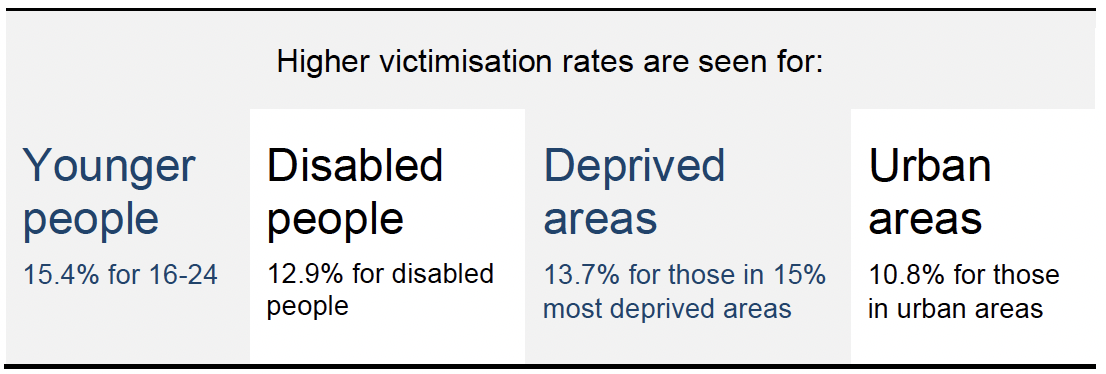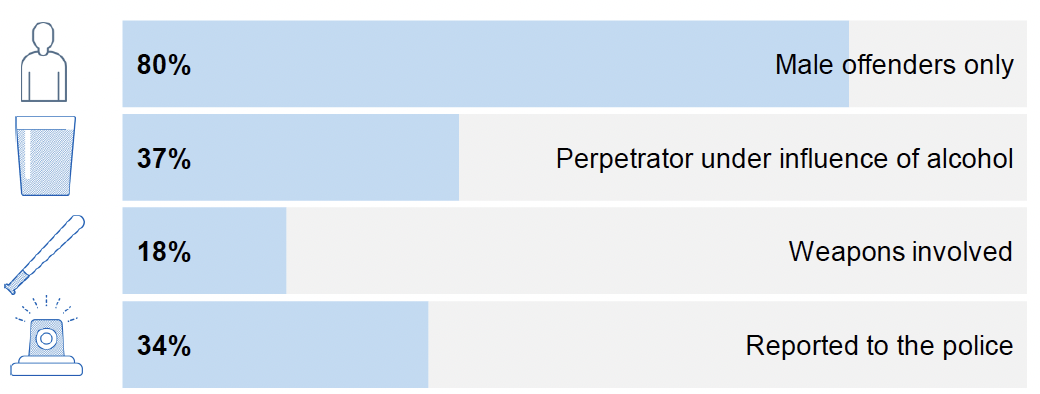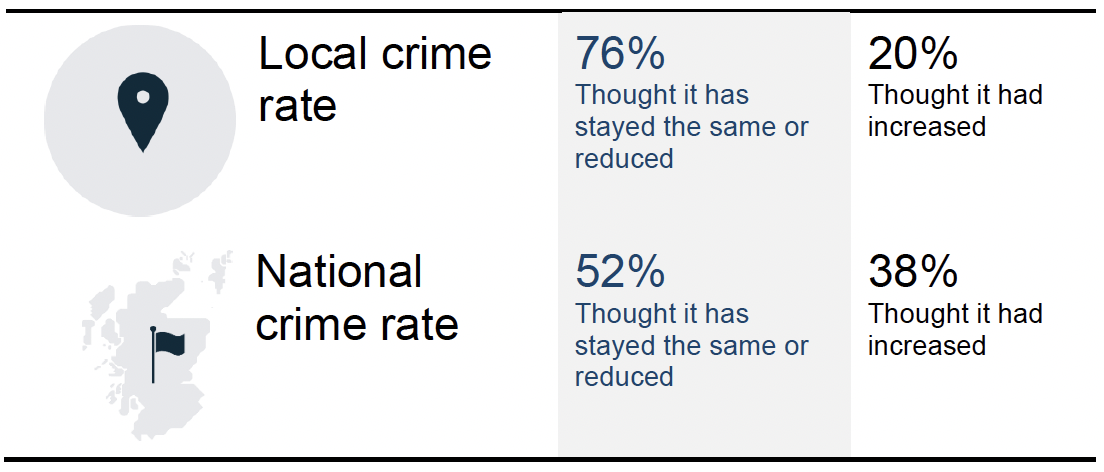Scottish Crime and Justice Survey 2021/22: Main Findings
Main findings from the Scottish Crime and Justice Survey 2021/22.
Executive summary
The 2021/22 Scottish Crime and Justice survey shows that the overall level of crime and the likelihood of being a victim of crime has fallen over the last 15 years or so. The latest findings also show that people feel safer in their local communities though there has been a fall in confidence in the police across a range of measures.
How did the SCJS adapt to the COVID-19 pandemic?
In order to help prevent the spread of COVID-19, the Scottish Government suspended face-to-face interviewing for the SCJS and the other household surveys on 17th March 2020. As a result, no interviews took place in the 2020/21 survey year. Interviewing restarted in November 2021 and was completed in December 2022, initially using a ‘knock-to-nudge’ approach with in-home, face-to-face, interviewing resuming in April 2022, when restrictions allowed.
More information on how the survey was adapted during the pandemic and how the latest findings compare with previous years can be found in Chapter 2.
What does the survey tell us about trends in overall crime?
The survey finds the volume of crime in Scotland, including incidents not reported to the police, has fallen by 53% over the last 15 years or so – from an estimated 1,045,000 incidents in 2008/09 to 494,000 in 2021/22.

The survey estimates that the number of incidents experienced in 2021/22 was lower than those reported in any year between 2008/09 and 2017/18. However, it indicates no change compared to the subsequent years (2018/19 and 2019/20).
Most adults (90%) were not victims of any crime in 2021/22 and victimisation has become less common over the last 15 years or so – the proportion of adults experiencing crime decreased from one-in-five (20.4%) to one-in-ten (10%) between 2008/09 and this latest year (2021/22). Since the last SCJS (2019/20), the proportion of adults experiencing crime has fallen from 11.9% to the lowest level since the SCJS began in its current form in 2008/09.
Despite the large reduction in overall crime in Scotland, victimisation rates continued to vary among the population in 2021/22. For example, the likelihood of experiencing any crime was higher among those living in the 15% most deprived areas and urban areas of Scotland, and lowest for those aged 60 and over.

As in previous years, crime was concentrated among victims of multiple victimisation – 3% of adults were victims of two or more incidents and this group experienced around three fifths (59%) of all crime in the year.
As in previous years, violent crime (accounting for 27% of all crime) was less common than property crime (73%), with the long-term decrease in overall crime underpinned by large falls in both categories.

The SCJS estimates that the police became aware of 29% of crime in 2021/22, which was lower than 38% in 2008/09 and 40% in 2019/20. However, when examining categories of crime which are comparable across the SCJS and police recorded crime statistics, both show a long-term decrease in the level of crime experienced in Scotland.
More information on overall crime in Scotland is provided in Chapter 3.
What does the survey tell us about violent crime?
The volume of violent crime has fallen by nearly three-fifths since 2008/09 (down by 58%). Since 2016/17, the volume of violent crime has fallen by 42% with more stability seen in recent years, suggesting that the volume of violent crime in Scotland has continued on a downward trend over the last fifteen years or so.
The proportion of adults experiencing violence has fallen from 4.1% in 2008/09 to 1.7% in 2021/22. This suggests that violent victimisation in Scotland has remained relatively uncommon since 2008/09, and has become an even less prevalent experience over the last 15 years or so.

Consistent with previous years, the majority of violent incidents were cases of minor assault resulting in no or negligible injury (69%), with instances of serious assault (2%) and robbery (7%) remaining relatively uncommon.
Unlike in previous years, no difference was found in the likelihood of experiencing violent crime by sex, disability, whether the respondent lived in a rural or urban area or between those living in the 15% most deprived areas and the rest of Scotland. However, similar to 2019/20, the likelihood of experiencing violence in 2021/22 was lowest for those aged 60 and over compared to other age groups.
The concentration of violent crime among repeat victims (those experiencing two or more violent crimes) was particularly pronounced. Whilst less than one-in-every-hundred adults (0.6%) was a repeat victim, their experiences of violence accounted for almost two-thirds (63%) of violent crime in 2021/22.
Consistent with previous years, the 2021/22 results show that most violent crimes involved offenders who were male, under the age of 40 and known (or previously seen) by the victim. Offenders being under the influence of alcohol or drugs was lower than 15 years ago, 46% in 2021/22 compared to 68% in 2008/09, but unchanged since 2019/20. Of violent incidents which involved someone seeing or hearing what was going on (i.e. the victim themselves or another witness, which was the case in 97% of incidents), 18% were said to have involved perpetrators with weapons, unchanged from 2010/11 and from 2019/20.
More information on violent crime in Scotland is provided in Chapter 4.

What does the survey tell us about property crime?
The proportion of adults experiencing property crime has fallen from 18.0% in 2008/09 to 8.7% in 2021/22, with the estimated number of incidents occurring down by 51% over the same period. Both the volume of property crime and victimisation rate have shown stability since the 2019/20 survey.

Vandalism continued to be the most common form of property crime experienced in Scotland (accounting for 35% of incidents) but has more than halved in volume since 2008/09. Other household theft (including bicycle theft) (34%) and personal theft (20%) were the next largest categories.
Similar to overall crime victimisation rates, experiences of property crime in 2021/22 were more common among people living in the 15% most deprived areas and urban locations, as well as disabled people, whilst people aged 60 and over were least likely to be victims. The 2021/22 SCJS found no difference in the likelihood of experiencing property crime by gender.

More information on property crime in Scotland is provided in Chapter 5.
What does the survey tell us about perceptions of the police?
Nearly half of adults (49%) said the police in their local area do an excellent or good job. This is a decrease from 61% in 2012/13 and from 55% in 2019/20. Victims of crime and those living in the 15% most deprived areas of Scotland were less likely to feel positively about the police than comparator groups.

The survey also looks at attitudes towards, and experiences of, more specific elements of policing (including policing effectiveness, community engagement and fairness). A majority of adults were confident in the ability of the local police for most aspects of police ‘effectiveness’ covered in the survey such as dealing with incidents as they occur and solving crime. An exception was in preventing crime where 46% of adults were confident in the police. These measures of confidence in police effectiveness deceased from a high in 2014/15.
Measures of police community engagement and fairness were less positive than effectiveness measures and, in line with those, they have also seen reductions in recent years.
The proportion of adults aware of the police regularly patrolling their area has fallen from 56% in 2012/13 to 39% in 2021/22 but is unchanged form 2019/20.
What does the survey tell us about perceptions of the justice system?
Consistent with previous years, the majority of adults knew little about the criminal justice system but were fairly confident about its operation. For example, around three-quarters of adults were confident that the system allows all those accused of crimes to get a fair trial and that everyone is able to access the justice system if they need it (76% and 74%, respectively). However, adults were less confident on other measures, for example, less than half (41%) were confident about the efficiency of the system and that appropriate sentences are given which fit the crime (40% confident).
More information on public perceptions of the police and the justice system is provided in Chapter 7.
What does the survey tell us about perceptions of crime and safety?
Three-quarters (76%) of respondents thought that the local crime rate had stayed the same or reduced in the two years prior to interview, up from 73% in 2019/20 and 69% in 2008/09. A majority of people (52%) now think the national crime rate has decreased or stayed the same, up from 45% in 2019/20 and 40% in 2009/10.

People were more likely to feel safe in their communities than they were 15 or so years ago – the proportions reporting feeling safe when walking alone in their local area or on their own at home during the night were higher in 2021/22 than in 2008/09, but are unchanged in the last few years.

Despite general improvements in perceptions of crime and feelings of safety since 2008/09, differences remain in the population. For example, females, disabled people, people living in the 15% most deprived areas, those living in urban areas, and victims of crime were less likely to feel safe, more likely to be worried about specific types of crime, and more likely to think they would experience crime in the coming year.
More information on public perceptions of crime and safety is detailed in Chapter 8.
How does the SCJS findings compare to other sources of information?
In 2021/22, the proportion of adults in Scotland estimated to have experienced crime was similar to that in England and Wales (10.0% compared to 10.4%). Since 2008/09, crimes recorded by the police in Scotland fell by 46% while the estimate of comparable SCJS crimes fell by 61%.
More information on comparisons with the Crime Survey for England and Wales and Recorded Crime in Scotland can be found in Chapter 3 and Chapter 6 respectively.
What other information is included in this report?
Chapter 9 of this report details findings from questions on experiences of cyber crime, harassment and discrimination, awareness and contact with the Crown Office and Procurator Fiscal Service (COPFS) and experiences of civil law problems. This chapter also details, for the first time, findings from a new question on veteran status of respondents including their demographics, victimisation rates and responses to key indicators and how these compare to the non-veteran population.
Contact
Email: scjs@gov.scot
There is a problem
Thanks for your feedback